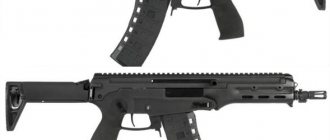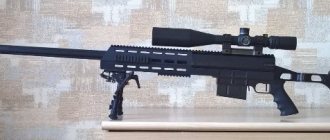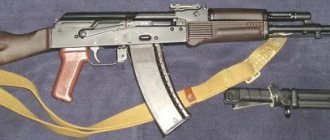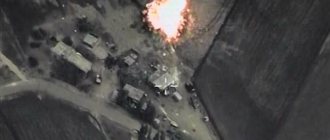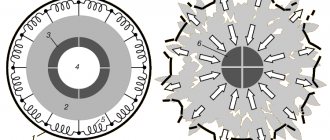Scientific and technological progress is developing rapidly. Unfortunately, its results lead not only to the improvement of our lives, to new amazing discoveries or victories over dangerous illnesses, but also to the emergence of new, more advanced weapons.
Throughout the last century, humanity has been racking its brains to create new, even more effective means of destruction. Poisonous gases, deadly bacteria and viruses, intercontinental missiles, thermonuclear weapons. There has never been a period in human history when scientists and the military collaborated so closely and, unfortunately, effectively.
Many countries around the world are actively developing weapons based on new physical principles. The generals very carefully observe the latest achievements of science and try to use them to their service.
One of the most promising areas of defense research is work in the field of creating electromagnetic weapons. In the tabloid press it is usually called an “electromagnetic bomb”. Such research is very expensive, so only rich countries can afford it: the USA, China, Russia, Israel.
The principle of operation of an electromagnetic bomb is to create a powerful electromagnetic field, which disables all devices whose operation is related to electricity.
This is not the only way to use electromagnetic waves in modern warfare: mobile generators of electromagnetic radiation (EMR) have been created that can disable enemy electronics at a distance of up to several tens of kilometers. Work in this area is actively carried out in the USA, Russia, and Israel.
There are even more exotic military uses of electromagnetic radiation than an electromagnetic bomb. Most modern weapons use the energy of powder gases to destroy the enemy. However, everything may change in the coming decades. Electromagnetic currents will also be used to launch the projectile.
The principle of operation of such an “electric gun” is quite simple: a projectile made of conductive material is pushed out at high speed over a fairly large distance under the influence of a field. They plan to put this scheme into practice in the near future. The Americans are working most actively in this direction; there is no information about the successful development of weapons with this operating principle in Russia.
Electromagnetic bomb
How do you imagine the beginning of World War III? Blinding flashes of thermonuclear charges? The groans of people dying from anthrax? Strikes from hypersonic aircraft from space?
Things could be completely different.
There will indeed be a flash, but not very strong and not incinerating, but rather similar to a clap of thunder. The “interesting” part will begin later.
Even turned off fluorescent lamps and TV screens will light up, the smell of ozone will hang in the air, and wiring and electrical appliances will begin to smolder and sparkle. Gadgets and household appliances that contain batteries will heat up and fail.
Almost all internal combustion engines will stop working. Communications will be cut off, the media will not work, cities will be plunged into darkness.
People will not be harmed; in this regard, an electromagnetic bomb is a very humane type of weapon. However, think for yourself what the life of a modern person will turn into if you remove from it devices whose operating principle is based on electricity.
The society against which a weapon of this kind will be used will be thrown back several centuries.
Patent No. 1370200 André Fachon-Villepleix
During World War II in Nazi Germany, the Fachon-Villeple idea was taken up by Joachim Hansler, an official at the Ministry of Armaments. In 1944, he designed and manufactured the LM-2 10mm cannon. During its tests, a 10-gram aluminum “shell” was accelerated to a speed of 1.08 km/s. Based on this development, the Luftwaffe prepared technical specifications for an electric anti-aircraft gun. The initial speed of a projectile containing 0.5 kg of explosives was required to be 2.0 km/s, and the rate of fire should be 6-12 rounds/min. This gun did not have time to go into production - Germany suffered a crushing defeat under the attacks of the Allies. Subsequently, the prototype and design documentation fell into the hands of the American military. Based on the results of their tests in 1947, a conclusion was made: for the normal functioning of the gun, energy was required that could illuminate half of Chicago.
The results obtained from tests of Gauss and Hansler guns led to the fact that in 1957, scientists participating in a symposium on hyper-velocity strikes held by the US Air Force came to the following conclusion: “…. It is unlikely that electromagnetic gun technology will be successful in the near future."
However, despite the lack of serious practical results that meet the requirements of the military, many scientists and engineers did not agree with these conclusions and continued research into the creation of electromagnetic ballistic weapons.
How it works
How can you create such a powerful electromagnetic field that can have a similar effect on electronics and electrical networks? Is the electronic bomb a fantastic weapon or can similar ammunition be created in practice?
The electronic bomb has already been created and has already been used twice. We are talking about nuclear or thermonuclear weapons. When such a charge is detonated, one of the damaging factors is the flow of electromagnetic radiation.
In 1958, the Americans detonated a thermonuclear bomb over the Pacific Ocean, which led to a disruption in communications throughout the region, there was no communication even in Australia, and there was no light in the Hawaiian Islands.
Gamma radiation, which is produced in excess during a nuclear explosion, causes a strong electronic pulse that spreads over hundreds of kilometers and turns off all electronic devices. Immediately after the invention of nuclear weapons, the military began developing protection for their own equipment from such explosions.
Work related to the creation of a strong electromagnetic pulse, as well as the development of means of protection against it, is carried out in many countries (USA, Russia, Israel, China), but almost everywhere they are classified.
Is it possible to create a working device based on other less destructive operating principles than a nuclear explosion? It turns out that it is possible. Moreover, similar developments were actively carried out in the USSR (they continue in Russia). One of the first to become interested in this direction was the famous academician Sakharov.
It was he who first proposed the design of a conventional electromagnetic munition. According to his idea, a high-energy magnetic field can be obtained by compressing the magnetic field of a solenoid with a conventional explosive. Such a device could be placed in a rocket, shell or bomb and sent to an enemy target.
However, such ammunition has one drawback: its low power. The advantage of such shells and bombs is their simplicity and low cost.
Electronics jammer
For the first time, the world saw a really working prototype of an electromagnetic weapon at the LIMA 2001 arms exhibition in Malaysia. An export version of the domestic “Ranets-E” complex was presented there. It is made on the MAZ-543 chassis, has a mass of about 5 tons, ensures guaranteed destruction of the electronics of a ground target, aircraft or guided munition at ranges of up to 14 kilometers and disruption of its operation at a distance of up to 40 km. Despite the fact that the firstborn created a real sensation in the world media, experts noted a number of its shortcomings. Firstly, the size of the effectively hit target does not exceed 30 meters in diameter, and secondly, the weapon is disposable - reloading takes more than 20 minutes, during which the miracle gun has already been shot from the air 15 times, and it can only work on targets in the open terrain, without the slightest visual obstacles. Perhaps for these reasons, the Americans abandoned the creation of such directed EMP weapons, concentrating on laser technologies. Our gunsmiths decided to try their luck and try to “bring to fruition” the technology of directed EMP radiation.
Other developments of NIIRP are also interesting. While studying the impact of powerful microwave radiation from the ground on air targets, specialists from these institutions unexpectedly received local plasma formations, which were obtained at the intersection of radiation flows from several sources. Upon contact with these formations, air targets underwent enormous dynamic overloads and were destroyed. The coordinated operation of microwave radiation sources made it possible to quickly change the focusing point, that is, to retarget at enormous speed or to accompany objects of almost any aerodynamic characteristics. Experiments have shown that the impact is effective even against ICBM warheads. In fact, these are not just microwave weapons, but combat plasmoids. Perhaps this is what prompted the Americans to create the HAARP (High Freguencu Active Auroral Research Program) complex in Alaska - a research project to study the ionosphere and auroras. Let us note that for some reason that peaceful project is funded by the Pentagon’s DARPA agency.
Is it possible to defend yourself?
After the first tests of nuclear weapons and the identification of electromagnetic radiation as one of its main damaging factors, the USSR and the USA began to work on protection against EMP.
The USSR approached this issue very seriously. The Soviet army was preparing to fight in a nuclear war, so all military equipment was manufactured taking into account the possible impact of electromagnetic pulses on it. To say that there is no protection from it at all is a clear exaggeration.
All military electronics were equipped with special screens and reliably grounded. It included special safety devices, and developed an electronics architecture that was as resistant to EMP as possible.
Of course, if you get into the epicenter of a high-power electromagnetic bomb, the defense will be broken, but at a certain distance from the epicenter, the probability of damage will be significantly lower. Electromagnetic waves propagate in all directions (like waves on water), so their strength decreases in proportion to the square of the distance.
In addition to protection, electronic means of destruction were also developed. They planned to use EMP to shoot down cruise missiles; there is information about the successful use of this method.
Currently, mobile systems are being developed that can emit high-density EMP, disrupting the operation of enemy electronics on the ground and shooting down aircraft.
Electronics in service with the Russian army
To understand what place the topic of electronic warfare occupies in the military-technical strategy of the Russian military department, just look at the State Armaments Program until 2022. Of the 21 trillion rubles of the total GPV budget, 3.2 trillion (about 15%) is planned to be spent on the development and production of attack and defense systems using sources of electromagnetic radiation. For comparison, in the Pentagon budget, according to experts, this share is much smaller - up to 10%. In general, the state's interest in weapons based on new physical principles has noticeably increased. Programs on it are now a priority. Now let's look at those products that have reached series production and entered service over the past few years.
Mobile electronic warfare systems "Krasukha-4" suppress spy satellites, ground-based radars and AWACS aircraft systems, completely block radar detection at 300 km, and can also cause radar damage to enemy electronic warfare and communications equipment. The operation of the complex is based on creating powerful interference at the main frequencies of radars and other radio-emitting sources.
The TK-25E sea-based electronic warfare system provides effective protection for ships of various classes. The complex is designed to provide radio-electronic protection of an object from air- and ship-based radio-controlled weapons by creating active jamming. The complex is designed to be interfaced with various systems of the protected object, such as a navigation complex, a radar station, and an automated combat control system. The TK-25E equipment provides the creation of various types of interference with a spectrum width from 60 to 2000 MHz, as well as pulsed misinforming and imitation interference using signal copies. The complex is capable of simultaneously analyzing up to 256 targets. Equipping the protected object with the TK-25E complex reduces the likelihood of its destruction several times.
The multifunctional complex "Rtut-BM" has been developed and produced at KRET enterprises since 2011 and is one of the most modern electronic warfare systems. The main purpose of the station is to protect manpower and equipment from single and salvo fire from artillery ammunition equipped with radio fuses. Note that up to 80% of Western field artillery shells, mines and unguided rockets and almost all high-precision ammunition are now equipped with radio fuses; these fairly simple means make it possible to protect troops from destruction, including directly in the zone of contact with the enemy.
The Sozvezdie concern produces a series of small-sized (autonomous) interference transmitters of the RP-377 series. With their help, you can jam GPS signals, and in a stand-alone version, equipped with power supplies, you can also place transmitters over a certain area, limited only by the number of transmitters. An export version of a more powerful system for suppressing GPS and weapon control channels is now being prepared. It is already a system of object and area protection against high-precision weapons. It is built according to a modular principle, which allows you to vary the area and objects of protection. Among the unclassified developments, MNIRTI products are also known - “Sniper-M” “I-140/64” and “Gigawatt”, made on the basis of trailers. They are used to test means of protecting radio engineering and digital systems for military, special and civilian purposes from damage by EMP.
Description
Consists of three trunks, fixed in the shape of a triangle. If necessary, they can rotate 90 degrees relative to the main part, which makes it possible to shoot with a 360-degree girth. Another detail is the folding stock, which extends when the wearer begins to aim. It is worth noting the weak recoil, given the speed of the projectiles fired. There are several models appearing in different games. Thus, in Dead Space: Extraction, the alternative rifle mode is a kind of shotgun, in Dead Space 2 it is an under-barrel grenade launcher.
It fires small-caliber cartridges fired at enormous, hypersonic speeds. The enormous kinetic energy of the projectiles allows not only to cause colossal damage to soft tissues, but also to crush bones. As a result, if the victim does not die instantly, he receives severe wounds, in addition to painful shock (provided that the target is not a necromorph). However, it is extremely ineffective against armored targets such as the Beast.
Shooting modes
- Main: a long machine-gun burst of three barrels. Effective at any distance.
- Alternative in Dead Space: Isaac gets down on one knee, the barrels separate, opening a circular “dagger” fire, effective in close combat.
- Alternative in Dead Space: Extraction: Shoots rounds like buckshot from a shotgun.
- Alternative in Dead Space 2: fires an explosive clip at range from a grenade launcher hidden in the center of the gun.
Ammunition
The cartridges are pulse charges. One cell slot can store up to 100 units. Cost in the DS1 store, 1250 credits for 25 charges.
Enemies and caches contain 37 charges.
Pulse pistol [edit | edit code]
The Pulse Pistol uses the same technology as the Pulse Rifle and is designed to be easily accessible to Air Caste pilots and Battlesuit pilots. The charging and trigger mechanism is the same as the Pulse Rifle, but the longer range has to be sacrificed in order to shorten the barrel, although the charge still has the enormous kinetic energy of larger versions of the Pulse weapon. Also, a pulse pistol uses a smaller caliber of ammunition than a rifle or carbine. The pistol uses a twenty-round magazine containing 1mm cartridges, but it can only be fired in single or four-shot bursts.
Universe of Constant War
The Tau (Empire) Pulse Rifle will be very familiar to all fans of the Warhammer 40,000 universe. Infantrymen from the Fire Caste of the same name carry the weapon as standard weaponry. In design, it resembles a massive long shotgun with rectangular shapes. The rifle fires special plasma projectiles, which, thanks to magnetic acceleration, cause great damage. Weapons were created to reliably resist the Orc horde at long range.
The Pulse Rifle concept emphasizes durability and range. It received an upgrade of containment fields compared to the plasma rifle. Thanks to this, she won at striking distance, but the damage decreased. In the Tau Empire, some of the priests of the Adeptus Mechanicus do not share their brothers’ contempt for this mechanism and are trying to improve it.
“Surprises await us again”
“Serving a sentence in a maximum security colony”: a court in St. Petersburg sentenced historian Sokolov to 12.5 years in prison
As Dmitry Kornev believes, today electromagnetic weapons still remain an experimental direction in the development of military thought. However, tests at test sites reported by Mikheev may indicate that KRET specialists managed to make a breakthrough in solving a number of key technological problems.
“I do not rule out that surprises await us again, like on March 1, 2018, and Mikheev’s caution may be caused by the fact that our scientists have created samples of electromagnetic weapons, which will soon be put into service. Existing information allows us to conclude that Russia has microwave guns that fire special ammunition that disables electronics within a radius of 1-2 kilometers,” Kornev noted
The expert suggests that KRET specialists have developed a compact source of electricity for electromagnetic weapons. According to Kornev, progress became possible due to the advent of a miniature nuclear reactor, which is equipped with the latest Russian cruise missile of unlimited range.
The task and principle of operation of modern weapons from the point of view of science
From the descriptions of the research, it can be understood that when a new generation weapon is launched, a powerful shock wave appears, which has a high frequency and enormous power. When an electromagnetic bomb explodes, the consequences will be as follows: microprocessor equipment (small household appliances, computers, etc.) will cease to function or will stop working for a while. The same applies to power lines, television and radio stations. Aviation will also not be able to function under the influence of rays.
The health of living beings is at risk: if the body contains various cardiac stimulants or metal implants, the chances of surviving a wave are reduced.
The components of the bomb are:
- Cylindrical resonator. The manufacturing material must have high electrical conductivity.
- A detonator that powers the device.
- Explosive substance.
During detonation, the resonator contracts. At the same time, the diameter of the cylinder decreases several times. The electromagnetic field, due to the inability to expand, acquires a higher oscillation frequency. Within a few seconds an explosion occurs and the waves hit the required area.
[edit] Sources
- Archimedes' Weapon
- Description of the Tenloss DXR-6 rifle on Wookieepedia
- Both types of weapons deal electrical damage. Based on the fact that the damage caused by a pistol is electrical, it can be assumed that by its nature the damaging element generated by such a weapon is a type of plasmoid (ball lightning). The rifle does not have a graphic image, but when fired, a sound similar to thunder from lightning is heard. Both types of weapons have Tesla coil-like devices on their bodies.
- High intensity laser propagation in the atmosphere. Archived from the original on February 22, 2012. LM Frantz, TD Holstein
Tau Empire
Main article: Tau weapons
Among all the races of the Galaxy, it was the relatively young Tau Empire that achieved perfection in assembling plasma weapons. The Tau weapons, which they call pulse weapons, are better and safer than the Imperial ones. While the Mechanicus uses a high-power constant magnetic field to contain plasma, the xenos use weak induced fields and generate plasma right at the moment of firing. Imperial plasma throwers are powered by dangerous hydrogen fuel, and Tau pulse cannons use solid ferromagnetic projectiles as ammunition. This allows you to avoid long-term storage of a dangerous substance and reduce the risk of malfunctions, as well as increase the effective firing range.
- Pulse pistols
are the most compact pulse weapons and use the same technology as the larger rifle. They have the same firepower, but a shorter effective range. - The Pulse Rifle
is the standard weapon of choice for Tau Fire warriors. It combines a high rate of fire, accuracy and range, but due to its length it is not very convenient at short distances. - The pulse carbine
is a modification of the pulse rifle for short-range combat and is additionally equipped with an under-barrel photon grenade launcher. - Rapid-fire cannons
are a block of rotating barrels, similar in loading principle to imperial rotary cannons. They have a high rate of fire and are perfect for installation on combat exoskeletons. - Pulse cannon
- installed on Hammerhead class warships and is more of a rail gun than a pulse gun. The large-caliber shells of this cannon easily penetrate thick armor and destroy multiple targets in one line.


